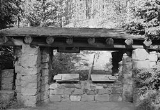
Obsidian Cliff Kiosk
Encyclopedia
The Obsidian Cliff Kiosk is a small structure that shelters an interpretive exhibit in Yellowstone National Park
at Obsidian Cliff
. The kiosk was built in 1931 as part of an effort to provide interpretive exhibits along the park's Grand Loop Road. In common with the Fishing Bridge Museum
, Madison Museum
and Norris Museum, the kiosk exemplifies the National Park Service Rustic
style. The interpretive exhibit was design by Carl Russell.
Yellowstone National Park
Yellowstone National Park, established by the U.S. Congress and signed into law by President Ulysses S. Grant on March 1, 1872, is a national park located primarily in the U.S. state of Wyoming, although it also extends into Montana and Idaho...
at Obsidian Cliff
Obsidian Cliff
Obsidian Cliff, also known as 48YE433, was an important source of lithic materials for prehistoric peoples in Yellowstone National Park near Gardiner, Montana. The cliff was named by Philetus Norris, the second park superintendent in 1878. It was declared a National Historic Landmark in 1996.The...
. The kiosk was built in 1931 as part of an effort to provide interpretive exhibits along the park's Grand Loop Road. In common with the Fishing Bridge Museum
Fishing Bridge Museum
The Fishing Bridge Museum is one of a series of "trailside museums" in Yellowstone National Park, Wyoming, USA, designed by architect Herbert Maier in a style that has become known as National Park Service Rustic. It is one of three parts of a 1987-declared National Historic Landmark, the Norris,...
, Madison Museum
Madison Museum
The Madison Museum is one of a series of "trailside museums" in Yellowstone National Park designed by architect Herbert Maier in a style that has become known as National Park Service Rustic. It was listed on the National Register of Historic Places in 1982, and is one of three parts of a...
and Norris Museum, the kiosk exemplifies the National Park Service Rustic
National Park Service Rustic
National Park Service rustic, also colloquially known as Parkitecture, is a style of architecture that arose in the United States National Park System to create buildings that harmonized with their natural environment. Since its founding, the National Park Service consistently has sought to provide...
style. The interpretive exhibit was design by Carl Russell.
External links
- Obsidian Cliff Kiosk, Near Obsidian Cliff on Grand Loop Road, Mammoth vicinity, Park County, WY: 1 photo, 1 photo caption page, 1 data page, at Historic American Building Survey
- Obsidian Cliff Kiosk at the Wyoming State Historic Preservation Office

